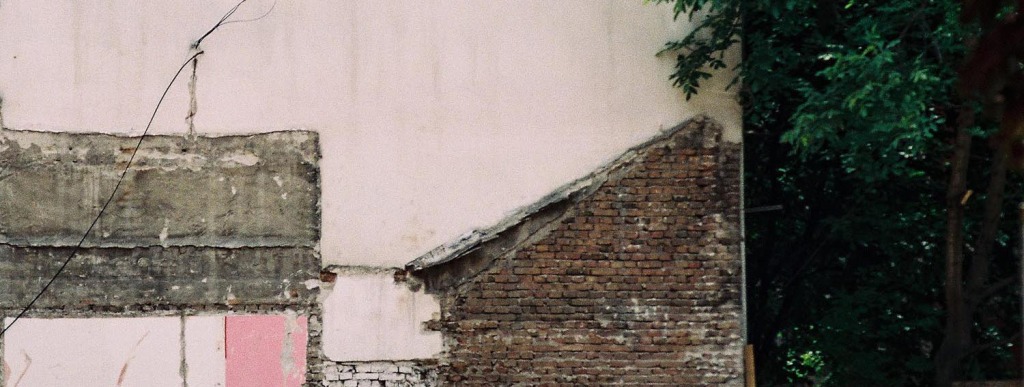„Prostor obuhvaćen imaginacijom ne može da ostane indiferentni prostor izložen merenjima i mislima geometra. Taj prostor je doživljen. I to doživljen ne u svojoj pozitivnosti, već sa svim pristrasnostima imaginacije.“
Gaston Bašlar (Gaston Bachelard), Poetika prostora
Jedna od nuspojava tranzicionog perioda je nadogradnja starih objekata, kao i ubrzana gradnja novih stambenih objekata, ne nužno idealnih, niti estetskih, ali prilagođenih potrebama i duhu vremena, na mestu starih, manje adekvatnih. Lice grada se menja, a intimni prostor, fizički i mentalni, poprima druge oblike i polako mutira.
Projekat pod radnim nazivom ARHITEKTURA SEĆANjA postepeno se razvija poslednjih deset godina, pravljenjem fotografskih beleški na lokacijama u fazi prelaska iz ruševina u novogradnju. Ovaj ciklus fotografija nije puko nabrajanje i deskripcija, iako, neminovno nosi dozu dokumentarnosti, bez obzira na to što su najstarije fotografije iz ove serije osim prelaska iz analognog u digitalno pretrpele i uticaj vremena, u vidu ličnog zaborava, pa tako neki lokaliteti ostaju nepoznati i neprepoznatljivi.
Fotografije predstavljaju problem igre spoljašnjeg i intimnog, postavljaju pitanje da li je rušenjem stare kuće zauvek sa zemljom sravnjeno i sećanje koje kuća nosi ili biva priključeno sećanjima nove zgrade. Ono što vidim i osećam, na takvim lokalitetima, je da prošlost i memorija starih obitavališta ostaje bukvalno utisnuta u memorijski kod zgrade u nastajanju, a bogatstvo psihologije koje se krije u zidovima nikad ne napušta konkretno mesto, dok „razgolićenost“ preostalih zidova pruža specifičan uvid u svojevrsnu skrivenu estetiku i likovnost tih bašlarovskih „kosmosa“.
_____________________________________________________________________________________________________________________________
“Space that has been seized upon by the imagination cannot remain indifferent space subject to the measures and estimates of the surveyor. It has been lived in, not in its positivity, but with all the partiality of the imagination.”
Gaston Bachelard, The Poetics of Space
One of the side effects of the transitional period is the accelerated construction of new housing [not necessarily ideal or aesthetic, but adapted to the needs and spirit of the time] in place of the old, less adequate. The face of the city is changing and the intimate space, physical and mental, takes other forms and is slowly mutating.
The ARCHITECTURE OF MEMORY project is a series of photographs that has gradually developed over the past ten years, making photographic records of locations in a transitional phase from rubble [ruins] into a newly constructed building. This series of photographs is not merely an enumeration and description, though it inevitably brings an element of documentation. Apart from the transition from analogue to digital, there is the impact of time in the form of personal oblivion. Thus, some sites remain unknown and unrecognisable for ever.
The photographs represent a problem and play between the intimate/inner and public/outer, raising the fundamental question whether the demolition of the old house forever erased the memory and the ‘genetic code’ that it carried, or whether it is added to and connected with the memories of the new building. What I see and feel at such locations is that the history and the memory of the old dwellings, become embedded in the memory of the building under construction. Both the psychological and emotional richness that is hidden in the walls never leaves the particular location, while the remaining ‘nude’ walls provide individual insights into the specific hidden aesthetics and artistry of Bachelard’s ‘Cosmos’ [Universe].

